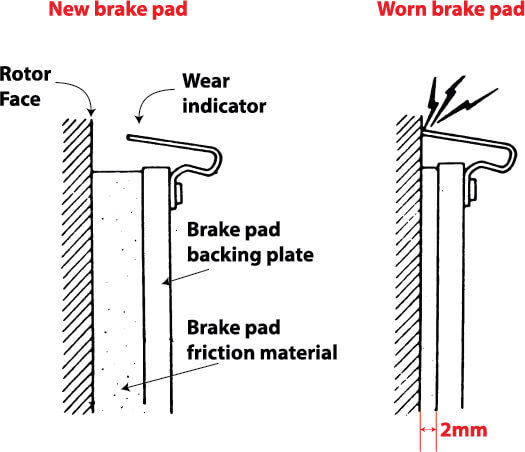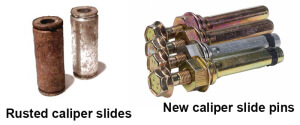When to replace brakes
When to replace brakes
While brake pads and rotors are designed to last tens of thousands of miles, they won’t last forever. Knowing when to replace your brakes can help you avoid costly repairs and, more importantly, prevent dangerous situations on the road. Here are some telltale signs that it’s time for a brake replacement.
The 6 signs you need brake service
1, Brake noise is a sign you should have your brakes checked
All brakes vibrate when they’re applied, but noise reduction features keep the noise at an acceptable level. When you notice a brake squeal, screech, or squeak, it’s time to have them checked out. Getting your brakes inspected at the first sign of noise can often catch problems early and avoid accelerated brake wear that can cost you a bundle.
2, If your brakes grind when you apply them, get them checked out
Brake grinding is often caused by a seized component or completely worn out brake pads. If you catch that early, the shop can unseize the component and most likely save you the cost of a full brake job. However, if you let it go, the seized component can cause rapid brake pad wear the point of completely wearing off the brake pad friction material. In that case, you’d be metal-on-metal.
3. Brake pedal pulsation is a sign of disc thickness variation
The brake disc (rotor) must rotate perfectly parallel to the wheel hub to provide smooth braking. Rust buildup on the wheel hub or uneven lug nut torque can cause lateral run-out that causes the rotor to rotate in a wobble. That causes brake pedal pulsation. Get it checked out right away. The shop should conduct a full inspection to locate the cause of the lateral run-out and correct it so it doesn’t happen again.
Drivers often ask when they should replace brakes. There are some general answers, but it really depends on how you drive and how you brake and whether the last brake job was done properly.
The rule of thumb is that your front brakes usually last about 40,000 miles. But that figure is based on a combination of highway and city driving. If you do more highway driving where you don’t use your brakes for long periods, they’ll last longer. And, if you drive in stop-and-go conditions or live in a hilly area, your brakes will wear out faster.
4. Brake light is on
A brake warning light is serious. It can be the sign of a leaking fluid line, a leaking caliper or wheel cylinder, or a failed brake hose. Never ignore a brake warning light. Get it checked out immediately.
Brake facts you may not have known
Front brakes in older cars wear faster than rear brakes, but that’s not true on newer cars
In older vehicles that don’t have accident avoidance systems or electronic brake force distribution, the front brakes perform almost 80% of the braking, so the front brakes wear out long before the rear brakes. In those older vehicles, rear brakes can last twice as long as the front brakes.
The rear brakes do provide some braking effort, but they’re primarily designed to stabilize the rear end and prevent it from lifting during a stop. To visualize this, just think of a bicycle and imagine what would happy if you slammed on the front brakes at high speed without applying the rear brakes. The bike’s tendency is to flip over the front axle.
On newer vehicles, brake wear is more evenly distributed
On vehicles equipped with accident avoidance systems, automatic emergency braking, traction control and stability control, the electronic brake force distribution feature often applies the rear brakes first to reduce front end noise dive and forward weight movement. Applying the rear brakes first in hard braking situations prevents the forward weight shift that can put high stress on the front tires, which reduces their braking ability.
Why worn brakes make a squealing noise
Car makers install metal wear indicators on the brake pads that come in contact with the rotor once the brake pad friction material wears down to a replacement level. The wear indicators are designed to contact the rotor once the friction material wears down to 1.5mm-2mm in thickness. Once the wear indicators touch the rotor, you’ll hear a high pitched squeal when you’re driving.

Brake pad wear indicators
If your brakes wear out too soon
If you’re not getting long life out of your brakes, here are some of the most common causes:
• Poor stopping habits—You wait too long to apply the brake then brake hard to stop
- Poor quality brake parts—If you’ve had your brakes replaced at a chain operated repair shop or took advantage of a brake job “special” you might have low quality brake parts. To learn more about how this happens, read this post.
- Stuck caliper—Most brake calipers are “floating,” which means they apply the inboard pad until it contacts the rotor, and then the entire caliper moves in the opposite direction until the outboard pad contacts the other side of the rotor. The caliper moves on two “slide pins.” The pins are lubricated with high-temperature synthetic brake grease. As part of a quality brake job the technician removes the slide pins and checks their condition. If they show any signs of corrosion,

Replace corroded caliper guide/slide pins with new parts. Lubricate with high temp synthetic brake grease
they should be replaced. Next, the technician checks the condition of the rubber boots to ensure they keep water and road debris out of the slide area. Some technicians skip this step and just slaps in a set of pads without checking the slide pins. That’s huge mistake because it results in a stuck caliper. A stuck caliper causes the brake pads to stay in contact with the rotor which causes overheating and uneven pad wear. A stuck caliper can reduce brake pad life by almost 75%.
- Stuck brake pad—Brake pads move slightly during every pressure application and again when they’re released. The brake pad “ears” travel in a small groove in the caliper or the caliper bracket and those grooves can rust. Once that happens, the pad can no longer retract when you let off the brakes, so you get uneven pad wear. In a proper brake job, the technician cleans the grooves to remove rust and applies a light coating of special brake grease. If your vehicle uses anti-rattle clips, the technician replaces the hardware with new. Old anti-rattle clips rust and loose their ability to retain the pad yet allow it to slide. To learn more about anti-rattle clips, read this article
https://ricksfreeautorepairadvice.com/parts-need-brake-job/
©, 2015 Rick Muscoplat
Posted on by Rick Muscoplat
